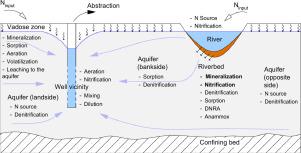Water Research ( IF 12.8 ) Pub Date : 2020-12-25 , DOI: 10.1016/j.watres.2020.116788 Gustavo Covatti , Thomas Grischek

|
Ammonium is an undesirable substance in the abstracted water of riverbank filtration (RBF) schemes, due mainly to the complications it causes during post-treatment. Based on the investigation of case studies from 40 sites around the world, an overview of the sources and behavior of ammonium during RBF is given. Typical concentrations of ammonium in the bank filtrate (BF) are between 0.1 and 1.7 mg/l. The most common source of ammonium in BF is the mineralization of organic nitrogen occurring in the riverbed, while the most common sink of ammonium is nitrification in the riverbed. Ammonium surface water concentrations do not directly translate to abstracted concentrations. Transformations in the riverbed play a critical role in determining ammonium concentrations, whereby riverbeds with high amounts of organic material will have more electron donor competitors for oxygen, thus limiting ammonium attenuation via nitrification.
中文翻译:

河岸过滤过程中氨的来源和行为
在河岸过滤(RBF)方案的抽象水中,铵盐是一种不良物质,这主要是由于铵盐在后处理过程中引起的复杂性。在对来自全球40个站点的案例研究进行调查的基础上,概述了RBF期间铵的来源和行为。库滤液(BF)中铵的典型浓度在0.1和1.7 mg / l之间。高炉中最常见的铵盐来源是河床中发生的有机氮矿化,而最常见的铵汇是河床中的硝化作用。铵表面水浓度不会直接转化为抽象浓度。河床中的转化在确定铵浓度方面起着至关重要的作用,



























 京公网安备 11010802027423号
京公网安备 11010802027423号